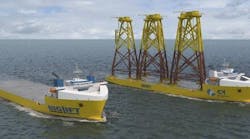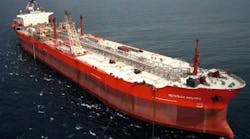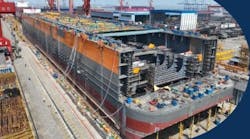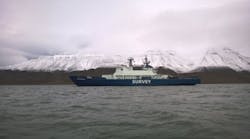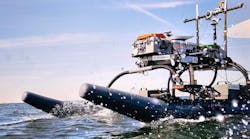Compared with depths and distances encountered at North Sea locations, collecting first oil from the Irish Sea seemed a relatively simple exercise.
The Lennox Field, containing an estimated 60MM bbl recoverable, lies below less than 15 meters of water roughly eight km off the coast of northwest England. Depth at the Douglas Field, estimated to contain 90MM bbl, is just 27 meters.
Combined flow from these fields of 70,000 b/d, however, did not justify investment in a separate oil pipeline and shore terminal facilities - despite the short distances to a suitable landfall or even to one of the refineries in the Merseyside area. Instead, BHP decided to examine options for offshore loading which it had used successfully in its North Sea operations.
It was clear from the outset that the flexibility offered by an offshore bulk storage system would be required to safeguard against shutdown of the highly complex integrated production system when tanker loading was disrupted by storms.
Initially, BHP looked at the possibilities of acquiring an existing tanker for conversion as a permanently moored storage facility, but there were not many suitable vessels available which offered the double-sided specification incorporated in the safety plans. Modifying an existing vessel would have entailed considerable spending, including fitting of bow thrusters to help hold it in position at the exposed location.
Opting instead for a newbuild, BHP selected Japan's Ishikawajima Harima Heavy Industries to design and supervise construction of a 116,500-ton barge. In addition to being double-sided, this will have seawater ballast tanks, each 4.8 meters wide, positioned between the ten storage tanks as an extra safety measure.
The 207-meter long vessel, with 870,000 bbl of storage capacity, is due for completion by August 1995 at the Ishibras yard in Rio de Janeiro where it is being built. Although it will have a propulsion system to aid maneuverability, it is intended that the barge will be permanently positioned throughout the predicted 25-year life of the fields at a location in block 110/8a, north of the three-platform Douglas complex and out of the way of busy shipping lanes.
Technical challenges in designing the storage system included devising a reliable mooring system for the location where account has to be taken of currents, as well as the effects of wind and waves.
After model testing identified a risk that the storage unit might ride over a conventional soft single-point buoy while a shuttle tanker was attached in storm conditions, BHP decided to go for a catenary anchor leg rigid arm mooring (CALRAM). Bluewater was called in to design a customized system for the Liverpool Bay location.
Despite the comparatively shallow water depths of less than 30 meters, Bluewater engineers have had to design for tidal variations of up to nine meters as well as survival in winds as extreme as any experienced around the UK coast.
Because of the bottom effect, bigger waves have a different dynamic to those encountered in the North Sea. But the landlocked location between the UK and Irish coasts also means that seas calm down more quickly after a storm.
After extensive model testing to finalize the design, Bluewater commissioned the Brown & Root/McDermott Nigg yard in Scotland to build the CALMRAM for installation with the barge in the fourth quarter of 1995.
The barge will have its own crew trained in using the thruster system to achieve optimal positioning in relation to the mooring and a shuttle tanker during loading. A standby vessel with tug capability will be permanently on station to enforce a 1,000 meter exclusion zone - twice the radius of zones around the platforms - as an added safety measure.
Copyright 1995 Offshore. All Rights Reserved.
